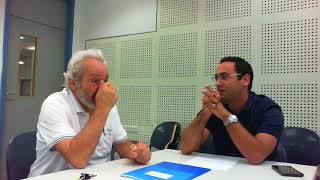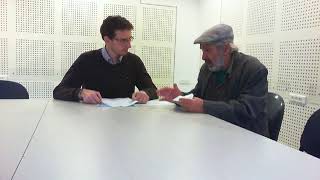Background (105-028-09-0) Omar and Rami
The patient is a retired male accountant who is being followed by his general practitioner for a few common chronic illnesses and complaints. The current visit was scheduled as a regular follow-up on those problems and their treatment. However the patient brings with him two unexpected issues to this visit. Firstly, the patient wants the doctor to help him decide whether to subscribe to use a special vitamin compound being marketed to him aggressively by his nephew as part of a multi-level marketing scheme; and secondly, he has developed, in the past few days, signs of a urinary tract infection complicating his prostate condition. The patient has also been suffering over the last year or so from a troubling decline in his memory, his attention and his organizational ability. As a result of these cognitive changes he is not able at this visit to focus in an organized way on all the items- old and new- on his agenda.
The action
In this video the doctor begins by presenting his agenda (which consists of managing the patient’s 4 chronic illnesses read from the chart) and the patient presents his agenda written on the small slip (that is concerned mainly with his fear of Alzheimer’s disease and his being pressured to buy vitamins) For most of the interview they continue to talk at cross purposes with the patient returning in a disordered manner to his agenda and the doctor attempting to force an organized (biomedical) problem-oriented approach. Along the way the doctor agrees to discuss the patient’s concerns at the next visit, but achieves only the most limited progress on advancing his own agenda. They part on good terms. The doctor’s body-language throughout supports his strategy to provide structure to the interview;
Educational opportunities
This video offers the opportunity to discuss the following issues:
- Doctor-centeredness v.s patient centeredness: It’s hard to find a better example of a “dialogue of the deaf”. From the beginning thru to the closing statement the doctor has defined his role in biomedical categories, while he relates to the patient’s agenda as a distraction. Despite this, there is some little melding of the agendae by the end of the interview.
- Milestone #2 : the central importance of defining the agreed agenda before proceeding with the work diagnosing and treating
- Cues and the response to cues: What can you learn about the inner world of this patient as revealed by his “cues” ? How did the doctor respond to those cues? What cardinal goals did the doctor achieve by his approach? [ its worth noting that postponing part of the discussion to a later visit as done here is a useful tool for “managing” when there’s not enough time for everything. ]
- Managing in general : What could have been done differently even within the alotted time to achieve more goals? For example, what specific things could the doctor have done to be more efficient in this visit (ie to achieve more tasks)? [ An important question is whether connecting better with the patient’s CASE could have helped free him to focus on the medical agenda? If so, then one can see how responding to psychosocial issues can promote the biomedical agenda. ]


